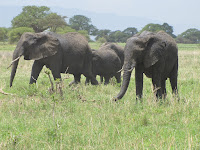 |
| En route to Africa |
Nairobi, January 20 - After almost two days of being in airports and planes we landed in Nairobi, Kenya. This would be our first stop of our African trip that would take us to Tanzania for a 7 day safari. As neophyte international travelers, our trip to Africa was the one we faced with the most trepidation. In terms of culture, climate, and infrastructure, we really had no idea what to expect. In spite of this, Africa also was also our most eagerly awaited part of our journey as we were scheduled to visit some of Tanzania's most famous wildlife parks including the Serengeti and Ngorongoro Crater!
After clearing immigration and collecting our luggage we were transferred to our hotel where we arrived in late afternoon. This would be a short visit to Nairobi as we would leave by 7:30 the next morning to take a bus to Arusha, Tanzania where our safari would begin. This left us only time to rest the kids and grab a meal at the hotel. Our experiences of Nairobi and Kenya would be captured through the bus window as we headed south to Tanzania.
 |
| Bus to Arusha |
The next morning, with our luggage securely strapped to the top of the bus we began what would be an 8 hour journey to Arusha. From our vantage point, Nairobi at first seemed to be a city of western style buildings, stores with familiar brands, and streets lined with billboards. On the other hand the streets were clogged with numerous small buses crowded with colourfully clad passengers and judging by the goods crammed in and ontop of the busses, they were all heading to the city's markets. Many of the busses were overloaded with bags of rice, great bunches of bananas skicking out of windows, and my favourite the 50 or so dead chickens tied to the roofrack and draped over the side of the bus. Yes, Africa was different.
 |
| Village through the bus window |
As we proceeded outside the city we encountered Africa's roads which seemed to be more about detours and dust. Along the way we passed through villages and towns alive with markets and trades people doing their work of repairing vehicles and making furniture in open air shops. Further along the landscape became less populated. Towns gave way to the occassional group of thatched huts within a dry and sparsely treed landscape. Here we hoped we might get our first glimpse of African wildlife but instead we were only rewarded with termite mounds and herds of cattle and goats watched over by young boys in traditional dress. Our encounters with African wildlife would have to wait until the next day when our safari would begin.
 |
| Open air market |
Arriving at the Tanzanian border we encountered numerous safaris vehicles. We began to understand how big the safari business was in Kenya and Tanzania. For us, our safari vehicle awaited us 2 hours away in Arusha. After purchasing our visas, we continued with the last leg of our bus ride. This took us by a dormant volcano and close enough to Mount Kilmanjaro to see its snowfields. An amazing site when you think that we were almost at the equator. Overall, it was an interesting ride and gave us a small taste of Africa, but perhaps our best site of the day was arriving in Arusha and seeing Emmilian, our safari guide. After quick introductions it was off to our hotel to remove a thick coat of African dust. Tomorrow our safari would begin.

















